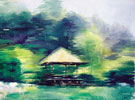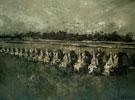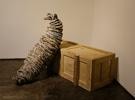SEEKING THE SPLENDOR OF THE PAST —Excavating Sakya Northern Temple
Zhang Jianlin
The wide streets of the Sakya County seat are paved with flat stones. The cement houses in imitative Tibetan style appear clean and bright under the sunrays. Shops, restaurants, teahouses, inns and various local companies are lined up on the sides of the road, and an internet café is evidence that the information age has arrived even here. Yaks and goats stroll along the streets in the morning and night, and the air is filled with the mixed flavors of yak butter, manure, Sichuanese food... Tibetan folk songs and pop music float out of the various storefronts. The county seat becomes the center of activity every weekend, with the crowds consisting mostly of three types of people, students in their blve and white school uniforms, lamas in their red robes, and local peasants in their Tibetan clothing, interspersed here and there with the odd tourist.
In the black and white photos taken by old reporter Chen Zonglie in 1957, the towering Sakya Monastery is surrounded by a broad expanse of agricultural fields, with trees in the distance blocking out Zhuoma Pozhang and Pincuo Pozhang. The Zhongqu River hugs the base of the mountains, and two small bridges traverse the waters. Temples and houses dot the mountainside, and a cloud of smoke hovers over the ridge in a scene that appears as if from another world. With such an enormous change in just fifty years, what would the scene have looked like a century ago in Sakya, which once ruled all of Tibet? We have come to this ancient valley to seek out the past splendor of Sakya.
July is the best time of year in Tibet. On the nearby Shaanxi Plateau, Xian is already blazing in the intense summer heat, but the fields around Sakya County are painted gold by the blooming rapeseed flowers. In order to assist in the establishment of an artifact preservation plan and implement a maintenance project for the ancient buildings of the Sakya Monastery, the Tibetan Autonomous Region Department of Relics and the Shaanxi Archaeological Research Institute have arranged for the Shaanxi Archaeological Research Institute to spend two years investigating and excavating the Sakya Northern Temple. The archaeological team arrived in Sakya County under the auspices of the Tibetan Autonomous Region Department of Relics on July 7, 2005 to begin their work with the assistance of specialists from the Tibet Museum. Through two years of hard work, the original face of the Sakya Northern Temple slowly began to emerge before our eyes. Few people in Tibet are unaware of the ancient Sakya Monastery. This, the most important temple of the Sakya Sect of Tibetan Buddhism, is located in the Sakya County seat and on the slope north of the Zhongqu River. It is separated into two temples, northern and southern, with the Southern Temple located in the county seat and the Northern Temple located on the slope by the river. Not only is the monastery complex extremely large, the buildings are also of a special design and construction, and home to a rich collection of Tibetan artifacts. It has played an extremely important role in Tibetan history, and in 1961 it was named among the first batch of nationwide protected historical sites.
The Northern Temple was the first of the two complexes to be constructed. In 1073 AD, Goinchu Gyibo, a descendent of the Khon aristocratic clan of the Tubo Kingdom, began by constructing a small temple for religious cultivation on the slopes of Wenpo Mountain along the northern bank of the Zongqu River, which later came to be called the Sakya Kwobu. In Tibetan, Sakya means gray, which is why the place took the name Sakya Monastery. Though Goinchu Gyibo was the founder of the Sakya Sect, the sect was in its infancy at the time, and the temple was of a very simple construction.
Goinchu Gyibo’s son Kungpa Nyingbo followed in his father’s studies of the Dharma and traveled throughout the land to seek out mentors in the esoteric doctrines, completing the teachings of the Sakya Sect. His fame spread, and he became known as a Sachen, or Great Sakya Master, later anointed as one ofthe “Five Founding Fathers of Sakya”. Kungpa Nyingbo was not only instrumental in the establishment of the Sakya Sect; he also made key contributions to the construction of the Northern Temple. The “Lazhangsha” was a cultivation center he constructed, and the “Gurong” complex he later constructed consisted of a protector spirit shrine, a statue hall and a book depository. Kungpa Nyingbo also constructed the main building of the Northern Temple, which he later expanded and added a golden roof. A wing was added during the Yuan Dynasty, supported by eight colvmns. Subsequent Sakya leaders continued to expand construction on the slope, eventually creating a massive complex of stacked buildings.
Tradition states that between the Buddha shrines, protector spirit shrines, palace halls and residences there were 108 buildings in all. Construction in the Northern Temple area came to a close after the fourteenth century as the religious activities shifted to the south, and the Northern Temple had grown quiet by modern times. Many of the buildings had collapsed by the 1950’s, and after the destruction of the 60’s, all that remained was a tattered surrounding wall. Some of the more important buildings have been restored in recent decades.
The Southern Temple was constructed by Benchen Sakya Sampo in 1268 on request of Chogyal Pakpa. Chogyal Pakpa (1235-1280) is considered to the fifth forefather of the Sakya Sect. At the age of ten he traveled with his uncle Sakya Pandita Gonggar Gyaltsen to Liangzhou. The Sakya Pandita died of an illness in 1251 while in Liangzhou. Chogyal Pakpa took over as Pandita, and was received by the Yuan Dynasty government. He was called on by Kublai Khan, who named him as a Great Master of State in 1260, a development which spread the inflvence of the Sakya doctrines. In 1268, Chogyal Pakpa appointed Benchen Sakya Sampo as protector of the 130,000 families of Tibet, and the region was officially incorporated into Chinese territory. In 1269, this “young, noble and enlightened scholar: was appointed as “Imperial Dharmaprince” of the Yuan Dynasty.
The South Temple, constructed on flat land south of the Zhongqu River, is a monastery complex built in the style of a fortress. The main buildings were constructed gradually according to a master plan. There are two concentric surrounding walls, with the inner wall standing large and thick with a main gate facing east, towers at each of four corners, and a depression running along the top wide enough for a man to walk. The outer wall “goat-horse wall” is shorter in comparison, constructed out of adobe and surrounded by a moat. The earliest building inside the walls is the Lakhang Chenpo (Great Buddha Temple), constructed of a portico, sutra hall, Oudong Rencheng Lakhang, Puba Lakhang, Ciwai Lakhang and Lakhang Lazhang. The interior is home to many large statues Buddhas, Bodhisattvas, Vajras and Sakya masters




